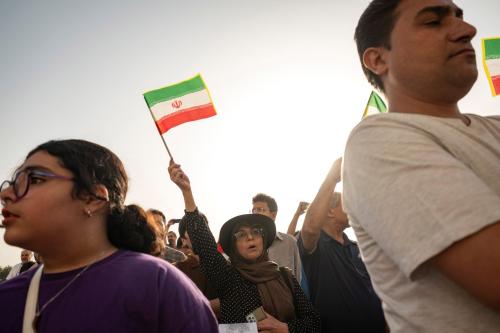Last month, stories appeared simultaneously in The New York Times and The Washington Post claiming that the Bush Administration had finally settled on a campaign plan should the President decide to launch an invasion of Iraq this winter. Days later, other newspapers followed suit, some providing additional details of the reputed plan to begin an attack on Iraq with only limited ground forces and rely mostly on air power and special forces as in Afghanistan. This week, The Washington Post ran still another story describing the same plan and noting the apprehensions of many senior military officers about it.
The strategy that emerges from these various stories calls for an attack on Iraq to begin without a massive build-up of air and ground forces. The initial blows would be struck mostly by the U.S. air forces already in the region coupled with a limited ground offensive by roughly 20-30,000 soldiers and Marines. Additional forces would flow into the region afterwards, until the build-up exceeded 200,000 American troops—and possibly as many as 300,000. The ground campaign would be timed to begin soon after the airstrikes began, perhaps even simultaneously. But because the starting ground force would be small, unless all Iraqi resistance collapsed, the initial ground campaign would be limited to the seizure of a foothold inside Iraq that would then become the staging area for a larger follow-on advance to Baghdad and Tikrit. Finally, the purported plans suggest that U.S. ground forces would be deployed in Western Iraq (to prevent Iraqi Scud launches at Israel) and northern Iraq (to secure the Kirkuk oilfields and keep the Kurds and Turks from fighting), although it is unclear whether this would entail small teams of special forces or larger formations of combat troops.
We do not know if this actually is the campaign plan that the U.S. intends to employ in a hypothetical war with Iraq, although the simultaneous stories in The Times and The Post suggest it was intentionally leaked by the Administration. Perhaps these stories represent disinformation; it is difficult to justify a deliberate leak of real operational plans which are rightly regarded as some of the most closely held secrets of the U.S. government. Nonetheless, because this plan raises serious concerns that could result in unnecessary additional casualties and costs, it is important to examine its potential risks.
A BAD COMPROMISE
The leaked plan appears to be a compromise between the “light” option favored by some civilians in the Department of Defense, and the “heavy” option favored by the uniformed services themselves. Over the summer, stories emerged claiming that Pentagon civilians favored a war plan for Iraq that would be heavily dependent on air forces and special operations forces, and involve only a small ground contingent of 20-30,000 troops. It was said that these officials opposed a larger ground contingent because they expected Iraqi resistance to be minimal and believed that the Afghan war proved that it was unnecessary to employ the larger ground forces (5-7 divisions, 100-150,000 ground combat troops with 200-300,000 troops overall) favored by the Joint Chiefs and the U.S. Central Command for a war with Iraq.
The light plan was said to have several advantages. First, because it did not require the deployment of large armored divisions to the Gulf, it preserved some degree of surprise since the Iraqis would not see the same kind of build-up that preceded Operation Desert Storm in 1991. Second, it was claimed that some Pentagon civilians were determined to prove that the new and improved U.S. military could do with small, light forces what the uniformed services believed could only be accomplished with big, cumbersome formations. This last point had less to do with the requirements of a war with Iraq, than with Secretary Rumsfeld’s ongoing battle with the services over the future structure of military forces.
The leaked plan appears to split the difference between the two positions. Essentially, the U.S. would start with the light plan by attacking initially with large air and airmobile forces but only small ground forces. However, the additional heavy forces following on the initial assault would provide a safety margin should the light plan fail. In other words, if the Iraqis did not collapse under the blows of the initial attack by the light force, the flow of armored divisions into the region would ensure that the U.S. could then shift to a more traditional invasion with the heavy force favored by the uniformed services.
THE UNBEARABLE RISKINESS OF BEING LIGHT
There were two sets of problems with the original “light” campaign plan. First, it provided inadequate ground troops to ensure a stable transition and occupation of Iraq after Saddam Husayn’s fall. In exercises and simulations of post-Saddam Iraq conducted during the summer and fall, it became clear that without a large U.S. (or, ideally, multinational) military presence in Iraq as the regime collapsed, Iraq itself would likely fall into chaos, and reconstruction would be very difficult. The new compromise version of the operational plan, calling for a “rolling” attack that increases in size as it progresses, does address this problem by providing for the eventual build up to the necessary force levels of 200-300,000 troops to ensure order throughout the country.
However, the leaked plan still fails to address the second problem of going light—that trying to defeat Iraq with only limited ground forces runs a serious risk of producing a longer war with higher casualties for the United States, Iraq’s neighbors, and the Iraqi people themselves. Throughout history, starting a war with a weak initial attack and then building up to a larger effort has been a recipe for disaster. In Vietnam, the Rolling Thunder bombing campaign failed in part because it was “rolling.” In contrast, as the success of Desert Storm’s ground campaign illustrated, the best way to win a war quickly and decisively is to strike with tremendous power right from the outset—to knock the adversary off balance and then prevent him from ever regaining it. By starting off small, the U.S. risks not hitting the Iraqi armed forces hard enough to crack their will to fight and not having the force to follow up with additional hammer blows. As a result, after the first few days of small punches on the ground, the Iraqis might be able to recover their balance, which could lead to a longer and costlier war.
Starting the war with only small ground forces means it would be difficult to mount the kind of overwhelming assault that would be most likely to cause Iraqi resistance to collapse quickly and perhaps turn against Saddam. Iraq’s armed forces are no match for America’s, but if given the chance they could put up enough of a fight to allow Iraq to inflict significant casualties before the regime falls. Although most Iraqi soldiers are unlikely to offer more than token resistance, it would be imprudent to assume that the entire Iraqi armed forces will simply disintegrate at the first “whiff of grapeshot.” During the Persian Gulf War, the Republican Guard fought very hard (albeit, very poorly) over something as insignificant as Kuwait. This time around, it would be prudent to expect that the Republican Guard, the Special Republican Guard, and various members of the Fidayin Saddam, the Special Security Organization, and other of Saddam’s security forces will fight hard for the regime—a force that could exceed 100,000 men. This is a sizable contingent that could inflict considerable casualties on U.S. forces or Iraqi civilians (especially in urban combat) if it is not taken seriously and crushed quickly.
Indeed, the speed, cost, and decisiveness of a campaign against Saddam Husayn’s regime is likely to be directly proportionate to the size of the ground forces the United States employs. The more U.S. forces can move fast, maintain momentum, and retain the initiative, the more certain the likelihood of victory, the sooner the campaign will be over, and the fewer the casualties that America or the Iraqi people will suffer. One of the great dangers of this campaign is that the U.S. will not bring enough force and then find itself bogged down by unforeseen developments. In war, things always go wrong and it is crucial to have ample forces on hand to deal with unforeseen problems, particularly on the offensive, when having insufficient forces to deal with the unexpected can fatally delay an attack. Against Iraq, a smaller ground contingent might not have the forces to envelop, bypass, or bound over strong Iraqi defensive positions and cities, which would then cost time and casualties to assault. Similarly, U.S. forces might not have the strength to seek out and aggressively suppress the artillery and multiple-rocket launchers that Iraq could use to fire chemical and possibly biological weapons at our troops. In ground warfare, being small doesn’t make you quick and nimble, it makes you tentative.
Moreover, as some of the newspaper articles suggest, the leaked plan appears to call for a pause in ground operations after seizing an initial foothold in Iraq. During this pause, the additional ground forces would flow into the theater that would be needed to enable a subsequent drive on Baghdad itself. The bulk of U.S. combat operations would shift to airstrikes during this period. Again, military history has repeatedly demonstrated that such pauses invariably result in higher casualties and greater risk of defeat because it enables the adversary to recover and react to the initial attack. Every major offensive of World War I failed because the attacker did not have adequate forces (and mobility) to sustain an advance if it achieved a breakthrough, and so the defender was able to recover and bring in reserves to bog down the attack. A critical element of Blitzkrieg (the answer to the failures of the First World War) was the relentlessness of the offensive drive which never allowed the defender time to recover.
The leaked plan may also lean too heavily on U.S. air power to try to win a war against Iraq. Any invasion of Iraq must include a powerful air component. However, the importance of speed to the operation argues against preceding the war with a lengthy air campaign as we did in 1991 or allowing for a pause in ground operations in which air forces will carry the burden of the campaign. This time around, a lengthy preliminary bombardment would be unnecessary. Although there is a tendency to marvel at the new power of American air forces (and there is no question that they are in a league by themselves), it is easy to forget how powerful U.S. ground forces have become. A U.S. armored or mechanized division is the most powerful ground force on the planet and no Iraqi formation is its match. Iraq’s Republican Guard and the Iraqi Army’s heavy divisions have shown they have the discipline and commitment to withstand a massive U.S. air campaign, but they lack the combat skills and equipment to withstand a massive U.S. ground campaign.
If the United States is willing to deploy 3-5 heavy divisions, those units will be more than capable of defeating the Iraqi armed forces by themselves and will not need a great deal of help from America’s magnificent air forces—although every little bit counts. Even the best of Iraq’s ground forces were hopelessly outmatched by U.S. ground forces in 1991, and since then they have gotten stronger and the Iraqis have gotten weaker. Consequently, the U.S. does not require a long, preparatory air campaign to weaken Iraq’s ground forces before it attacks—the force balances are already heavily weighted in America’s favor. The bottom line is simply that the importance of speed to this campaign argues against a lengthy preparatory bombardment. It is unlikely that the U.S. would lose even if the invasion moved slowly, but the slower it moves the higher the costs the U.S., its allies, and the Iraqi people will have to pay.
The sooner that U.S. ground forces get into Iraq, the sooner they will be able to engage and destroy Iraq’s ground forces. This should to have two results. First, it should help persuade the Iraqi people that we are serious about removing Saddam Husayn and so convince them not to support the regime (or even convinve them to actively support U.S. forces). Second, it should help crack Iraqi military morale, including, hopefully, the morale of the Republican Guard. The sooner U.S. heavy divisions start crushing Iraqi heavy divisions, the sooner they will break the morale of the Iraqi armed forces. And the faster they break the morale of the Iraqi armed forces, the less fighting the U.S. will have to do. Indeed, the larger the ground forces the U.S. employs the greater the likelihood that the Iraqi regime might collapse without a fight at all whereas the smaller the force, the more likely that Iraqis will believe that Washington is not serious about removing Saddam Husayn and so the more likely that his troops will fight.
Finally, relying as heavily on air power as the leaked plan suggests could be quite risky. Of greatest importance, during the period of aerial bombardment, Saddam Husayn will have considerable freedom to counterattack. One of the key differences between Saddam’s Iraq and the Taliban’s Afghanistan, is that the Taliban had almost no ability to strike back at the United States or even against U.S. forces, and basically just had to remain on the defensive during Operation Enduring Freedom. Unlike the Taliban, however, Saddam Husayn has the capacity to mount a variety of different counteroffensive strategies—firing weapons of mass destruction at U.S. forces in the region or at Iraqi Shia and Kurds to create a massive refugee flow designed to slow our ground offensive; invading northern Iraq (unless U.S. deploys forces into Kurdistan ahead of time); launching Scud missiles at Israel and our other allies; mounting terrorist attacks against the U.S. homeland, Israel, or our other allies; igniting his own oilfields; and striking at other Persian Gulf oilfields. In truth, his capability to mount such counterattacks is more modest than the pessimists claim and U.S. capabilities to counter such operations are significant. However, it makes no sense for us to give Saddam Husayn an extended opportunity to launch such attacks, and this too argues for making the speed of the campaign the paramount goal. The longer the war drags on, the more likely the Iraqi regime will be able to execute one or more of these counterattack options, and the greater the damage they will be able to inflict.
CONCLUSIONS
There is no compelling strategic argument for trying to defeat Iraq with only a light force. The United States gets no points for style in this war, nor will any country who opposes the war somehow warm to it if the United States promises to do the job with only a small contingent. Instead, the opposite is true. If the United States opts to go to war with Iraq this winter, it is vital that it win quickly and decisively, with the least casualties to our U.S. forces, Iraqi civilians, and the other countries of the region.
The paradox of an invasion of Iraq is that the bigger the ground force the U.S. brings and the harder the U.S. military hits Iraq right at the start, the faster they can move, the lower the casualties the U.S. and the Iraqi people are likely to sustain, and the less the risk to Iraq’s neighbors who will have to support this operation. The smaller the force the U.S. employs, the slower it is likely to move, the greater the risk of casualties to U.S. forces and Iraqi civilians, and the greater the threat to the countries of the region. Moreover, the slower the advance, the more time the Iraqis will have to shift their forces, build new defenses, and devise traps and counterattacks for our troops. The longer that the war goes on, and the more cities the U.S. actually has to fight through, the more Iraqi civilians will undoubtedly die both in the fighting and at the hands of Iraqi regime forces attempting to maintain order. The longer the war goes on (and the higher the toll of Iraqi civilian casualties mounts), the more unhappy the populations of Iraq’s neighbors are likely to grow and the more time for Saddam Husayn to lash out at our allies in the region.
As a former Marine general once said, “No general plans to win a war just barely.” This is not a war that we should be trying to win “just barely.”
The Brookings Institution is committed to quality, independence, and impact.
We are supported by a diverse array of funders. In line with our values and policies, each Brookings publication represents the sole views of its author(s).



